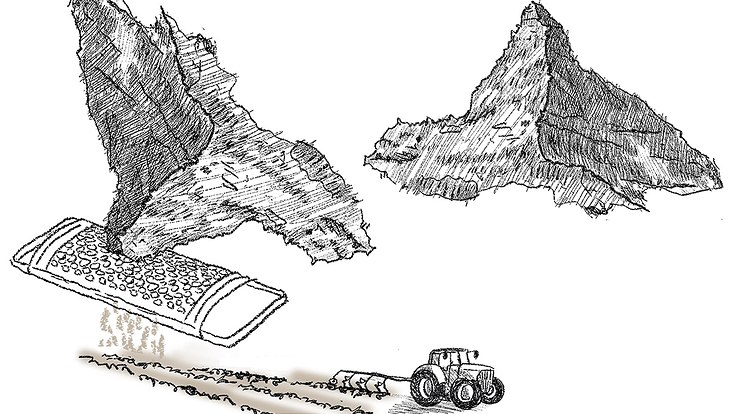Using rock powder to fix atmospheric CO2
11 June 2020, by Dr. Thorben Amann

Photo: Artwork: Rita Erven, GEOMAR
Climate change is transforming the planet, and forcing human beings and the environment to adapt. In order to keep global warming well below two degrees Celsius, emissions of carbon dioxide (CO2) have to be dramatically reduced, since the gas accumulates in and warms the atmosphere. Because politicians and society at large are achieving the “exit” from fossil fuels far too slowly, the likelihood of a climate catastrophe is on the rise. Consequently, climate engineering methods, in which human beings actively and intentionally seek to manipulate the climate system, must also be explored. Some of these methods are intended to remove and safely store atmospheric CO2; one example is enhanced weathering.
Together with my colleagues at Universität Hamburg’s Center for Earth System Research and Sustainability (CEN), I am currently investigating this option, in which rock powder is spread over certain types of soil. Once this has been done, rainfall sets certain chemical reactions in motion: the CO2 in the air reacts with water to form carbonic acids. These acids dissolve minerals in the stone powder, and the CO2, together with elements like calcium or magnesium, is absorbed by the solution. As a result, the CO2 becomes fixed in the groundwater and, in the long term, makes its way through rivers out into the ocean.

In laboratory tests, the method has proven highly efficient. We recently tested its effects in a greenhouse experiment involving ca. 90 rain barrels, each of which was filled with loamy soil and primarily planted. In order to intensify the weathering effect and fix more CO2, we spread a powder chiefly consisting of olivine, characterized by high water solubility, on the loam in nearly all of the barrels. In addition, we used coarser powder in some, and finer powder in others. When the same quantity is used, the finer grains offer more surface area – ideally providing more rock for weathering.
The barrels were sprayed on a regular basis to simulate rainfall. Since the rock powder selected had a relatively simple chemical composition, we were able to clearly identify the chemical processes at work: we could gauge the weathering effect on the basis of the pH value, and on how much magnesium and silicon the water in the respective barrel contained. This approach also allowed us to compare the different variants used.
Our experiment shows that, although olivine fixes less CO2 than theoretically projected, nonetheless an effect can be clearly observed. Due to their chemical compositions, other minerals (e.g. basalt) could yield an additional positive effect: the weathering process releases nutrients that are well suited as natural fertilizers. As a result, the crushed rock could be used to restore depleted soils and to complement industrial fertilizers. In turn, plants would grow better, allowing them to absorb more CO2 from the atmosphere. However, depending on the minerals used, heavy metals like nickel and chromium can also be released and, if they accumulate in the soil and reach a certain concentration, can be harmful to human health. In the course of our experiment, however, we detected no harmful concentrations of trace elements in the plants.
Given the possible side effects, additional, thorough experiments are called for. Whether or not rock powder is a viable candidate for reducing global warming is something that only larger-scale field tests, e.g. on crop fields and forests, can tell us. In this regard, the characteristics of the soil need to be kept in mind. Ideally, the soil should be prepared so as to offer optimal conditions for weathering. Warm and humid regions in the tropics and subtropics are particularly well suited, since higher temperatures accelerate the CO2 capture. A final consideration: which types of rock offer the best balance of sustainability and efficiency.
Thorben Amann
Dr. Thorben Amann is a Geologist at Universität Hamburg, where his research focuses on methods for removing CO2 from the atmosphere.
Further information on the priority program Climate Engineering in the brochure of the SPP 1689 »Climate Engineering«.
Associated research article:
Amann et al. (2020): Enhanced Weathering and related element fluxes – a cropland mesocosm approach
Newspaper: This article was first published as a guest article in the Hamburger Abendblatt as part of a monthly series on climate research. Find all articles of the series here.


